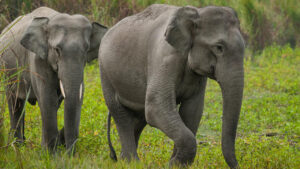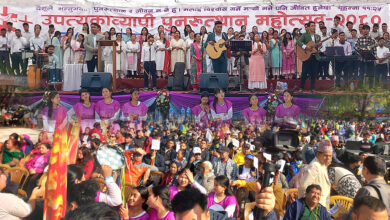274 people deaths from elephant attacks in Nepal
274 people deaths from elephant attacks in Nepal (in 20 Years)

Chitwan (Nepal): At least 274 people have been killed in elephant attacks in Nepal in the last 20 years. This information was given in the progress review of the study on human elephant coexistence in Sauraha today. Assistant Conservation Officer Ashok Kumar Ram has made public the report of the study conducted on elephants in four years and six months.
On the occasion, he said that 41 people were killed in Jhapa due to the elephant attac
k. At least 40 people have been killed in Bardiya, 26 in Chitwan and 23 in Saptari.
According to him, 21 people have died in Parsa, 20 in Bara, 16 in Siraha, 16 in Udayapur and 15 in Sunsari. Nine died in Sindhuli, nine in Dhanusha, eight in Morang, seven in Rautahat, five in Sarlahi, five in Kanchanpur, five in Makwanpur, four in Ilam, two in Banke, one in Mahottari and one in Nawalparasi. The study report states that 6,606 crops were destroyed.
The worst affected areas are Jhapa, Bardiya and Chitwan. Statistics show that the highest number of wild elephant attacks are in the age group of 25 to 65 years. Seventy-five percent of the elephant attack victims are in that age group. He said that there is a high risk around 500 meters from the forest area. In 20 years, 183 people have been killed by elephants in an area of 500 meters of forest area.
During the same period, 93 people were injured in the same distance. According to his study, elephants attack more after 4 pm and between 8 pm and 11 pm. The uneducated, the poor and the destitute are most affected. His study shows that 89 percent of such people are affected. It is mentioned that the human loss is more when the elephants come to the community to chase away the elephants, chase the elephants after drinking alcohol.
He said that a large number of Dalit tribes and poor communities living near the forest area and at the foot of the Chure were being attacked by elephants. The public has been urged to do the same as the elephants can only be comforted by lighting a fire in case they enter the settlement. It has been made public that there are more elephants attacking the Kutchi house. The majority of those killed were adult males, he said, adding that 25 per cent of the deaths were caused by elephant poaching attacks.
It was informed on the occasion that the incident has been increasing since 2009. At present, there are 227 elephants in the country. Stating that 37 of them are in trouble, he said that five of them are in more trouble. According to him, this animal, which prefers to live in a group, gets into trouble after leaving the group. He said that elephants used to use 51 corridors in different parts of the country and now only 39 of them are used.
He said that the use of elephants in 12 corridors has been reduced due to problems in their movement. That is why the elephants have not been able to move easily, he said. Most of the elephants that come to Nepal come from two regions.
It is found coming from West Bengal to Jhapa of Nepal and from West to Bandipur of Siraha. His study has shown that wild elephants migrate in groups of four to 10. Elephants are found to cause more incidents during the ripening of paddy. He informed that many incidents take place during the period from August to December. Ashok Kumar Ram is currently the Assistant Conservation Officer of Bardia National Park.
The study he did during his doctorate has been made public. Chief Conservation Officer of Chitwan National Park Haribhadra Acharya said the study would facilitate policy making. Dr Baburam Lamichhane, head of the National Nature Conservation Fund Sauraha, said the study would be helpful in reducing human-wildlife conflict.



